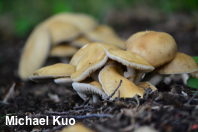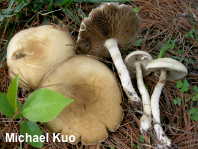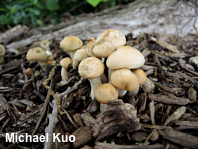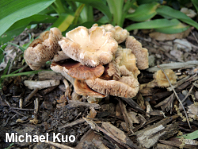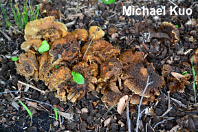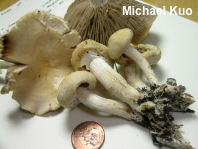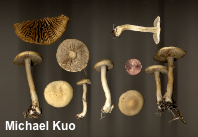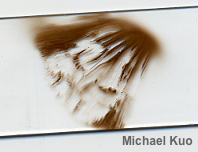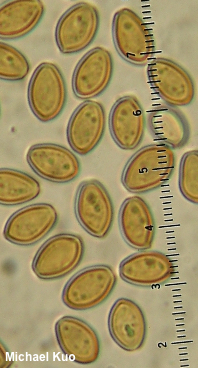| Major Groups > Gilled Mushrooms > Dark-Spored > Agrocybe & Cyclocybe > Agrocybe praecox |

|
Agrocybe praecox [ Basidiomycota > Agaricales > Strophariaceae > Agrocybe . . . ] by Michael Kuo Agrocybe praecox is a medium-sized inhabitant of urban settings, principally appearing on woodchips and compost or in disturbed-ground locations. Its cap ranges from brown to nearly white, and it features a partial veil that often leaves fragments hanging from the cap margin and a fragile ring on the stem. It is most frequently encountered in the spring and early summer (hence the epithet praecox), but it also appears in other seasons. There are several similar species, and physical features do not always separate them clearly. Fortunately, distribution and ecology can be used to distinguish most collections. While Agrocybe praecox is generally an urban woodchip denizen, two other North American species are found in more "natural," woodland settings: Agrocybe acericola in eastern North America, and Agrocybe biological species II in western North America. Agrocybe dura grows in grass (and usually has a paler cap), while Agrocybe paludosa grows in marshes and bogs (and usually features a skinnier stem). Description: Ecology: Saprobic on woody debris—woodchips, garden compost, etc.; growing gregariously in urban settings and in disturbed-ground locations; mostly appearing in late spring and early summer, but also in summer and fall, or over winter in warm climates; originally described from Germany; widespread in Europe; widely distributed in North America; also well documented in Japan and Oceania. The illustrated and described collections are from Illinois and Indiana. Cap: 2–9 cm; convex or bell-shaped at first, becoming broadly convex, broadly bell-shaped, or nearly flat; dry; bald; at first yellow-brown overall, becoming tan, pale tan, honey yellowish, or nearly white; the margin even, not becoming lined, sometimes adorned with whitish veil fragments. Gills: Narrowly attached to the stem; close or crowded; short-gills frequent; whitish at first, becoming grayish and eventually brownish to brown; at first covered by a white partial veil. Stem: 3–12 cm long and 5–15 mm thick; more or less equal above a slightly swollen base; bald or finely silky-fibrillose; whitish to pale brownish; with a thin, skirtlike, white ring that often develops a brown upper edge when spores mature (the ring sometimes disappears with development); basal mycelium white; base attached to white rhizomorphs. Flesh: White; unchanging when sliced. Odor and Taste: Mealy. Chemical Reactions: KOH on cap surface negative to orangish or yellowish. Spore Print: Bright medium brown. Microscopic Features: Spores 8–12 x 5–7 µm; more or less ellipsoid, with one end flattened for a 1–1.5 µm pore; smooth; thick-walled; dirty golden in KOH; brown in Melzer's. Basidia 25–30 x 7–8 µm; subclavate; 4-sterigmate. Cheilocystidia 40–75 x 12.5–22.5 µm; lageniform to subutriform; smooth; thin-walled; hyaline in KOH. Pleurocystidia 30–60 x 10–30 µm; utriform, with a wide basal section, or subutriform to lageniform; smooth; thin-walled; hyaline in KOH. Pileipellis hymeniform; terminal elements 7.5–25 µm wide; clavate to pyriform; hyaline to yellowish in KOH. REFERENCES: (Persoon, 1800) Fayod, 1889. (Smith, Smith & Weber, 1979; Arora, 1986; Flynn & Miller, 1990; Phillips, 1991/2005; Lincoff, 1992; Evenson, 1997; Barron, 1999; Roody, 2003; McNeil, 2006.) Herb. Kuo 05030311, 06040301, 05020605, 05040601, 06031003, 05091601, 05121602. This site contains no information about the edibility or toxicity of mushrooms. |
© MushroomExpert.Com |
|
Cite this page as: Kuo, M. (2021, February). Agrocybe praecox. Retrieved from the MushroomExpert.Com Web site: http://www.mushroomexpert.com/agrocybe_praecox.html |
